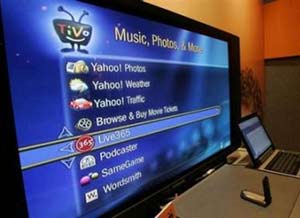It seems like every day, at least once, you encounter a pop-up ad window for some online video downloading service. From the TV series “Desperate Housewives” to those cool clips, it’s all there.
 |
|
Source: AP |
Are you excited about that? But does the Internet feel the same way?
ISPs in Distress
The answer from Internet Service Providers (ISPs), telephone, and cable companies is “No.” Small clips are manageable, but TV-quality programs, especially high-definition ones, can completely choke the Internet.
Nowadays, most of our online activities are quick and fleeting – checking emails here, browsing a website there. But imagine if we watched streaming videos over the web like we do on TV – at least a few hours each time. The Internet would have to bear a tremendous load.
Of course, the original infrastructure of the Internet cannot handle this load, and the costs of upgrading the network capacity to prevent these choking incidents are extremely high.
To help cover some of these costs, ISPs want to charge additional “fees” to content providers. If these fees aren’t paid, there’s no guarantee that large video files will reach their intended destinations.
Many people have reacted strongly to this plan, arguing that it could stifle creativity and is “unfair.” They want laws to ensure a “neutral” Internet, but the prospects for this seem very slim.
The crux of the matter lies in the question: How much do ISPs really have to spend to provide a few hours of video content on their networks each day?
Clearly, ISPs keep their cards close to their chest, but there are still ways for us to make educated guesses about their strategies.
The Truth Behind the Story
Let’s start with the numbers. According to the research firm TeleGeography, a continuous 1 Mb/s connection “tapping into” the Internet backbone in downtown Atlanta costs ISPs between $10 – $20 per month. ISPs are responsible for “transporting” the data “flowing” from that connection to users.
One Mb/s doesn’t sound like much, but ISPs always multiply bandwidth when delivering to users. It’s estimated that ISPs typically sell a bandwidth that is 30 times greater so that end users can connect simultaneously to the Internet.
Thus, bandwidth resembles traditional telephone service. The number of telephone lines from a home to the local exchange is always more than the number of lines going out from the exchange. If everyone picks up the phone at the same time, some calls will fail because there aren’t enough outgoing lines. However, this rarely happens, so the system continues to operate normally.
Shattering the Business Model
For broadband networks, a 1 Mb/s connection is sufficient to serve 40 DSL accounts, each achieving a maximum speed of 768 kb/s, typical for a primary DSL connection. The cost to provide data to each of these DSL users is only about 25 to 50 cents per user per month.
If these DSL accounts only use the Internet for web browsing, reading emails, or occasionally downloading files, there are no issues. But if all 40 subscribers try to download the evening news simultaneously, problems will surely arise.
If the connection speed is 2 Gb/s, ISPs incur about $1. This is a very small figure compared to the subscription rates of $25-47 per month they charge for DSL. However, they also have to pay sales, technical support, warranty, and a host of other miscellaneous costs.
If 40 users start downloading 5 TV-quality movies each month, excluding the maintenance costs for the DSL line, ISPs could lose up to $4.50 per month. Still, this is not high enough to disrupt their existing business model.
But if users start watching Internet TV for 8 hours a day, the costs for ISPs would skyrocket to $112 per month.
To cope with this “market crash,” BellSouth plans to “cap” the types of data flowing over the network: which types will be free and which will incur additional fees. Other options include charging fees to service providers, termed “guarantee” payments to ensure their content is delivered.
Meanwhile, opponents believe that allowing ISPs to charge additional fees carries risks. “Who knows if they’ll use that fee to expand bandwidth?” said an official from Google.
Thien Yi


















































